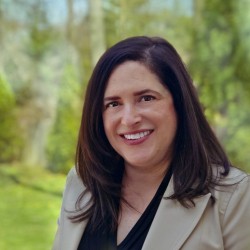Episode Summary
Millions of Americans rely on over-the-counter medicines known as OTCs to treat conditions such as allergies, sleep issues, or pain. Following the COVID-19 pandemic, OTCs have become an even more essential part of the treatment toolbox as people increasingly look for cost effective ways to take greater control of their health. Today, we're going to take a look at the value created by OTC medicines to the US healthcare system as we walk through some of the top findings from CHPA's latest OTC value study.
Note: IRI has since changed its name to Circana
Listen
Read
- Episode Transcript
-
Speaker 2: Welcome to CHPA Chat, conversations in the consumer healthcare industry with Anita Brikman.
Anita Brikman: Hello, listeners. Here we are with another episode of CHPA Chat. As I just said, millions of Americans rely on over-the-counter medicines known as OTCs to self-treat common conditions such as allergies, sleep issues, or pain. Following the COVID-19 pandemic, OTCs have become an even more essential part of the treatment toolbox as people increasingly look for cost effective ways to take greater control of their health. In fact, many more are turning to the drugstore aisle or e-commerce sites rather than visiting a healthcare provider.
Today, we're going to take a look at the value created by OTC medicines to the US healthcare system as we walk through some of the top findings from CHPA's latest OTC value study, which was conducted in partnership with IRI, Information Resources, Incorporated. Joining me today are Kristin Hornberger, IRI's executive vice president and practice leader for healthcare, along with Mindy Albuck, IRI's principal and team lead for Client Insights. And we're joined by our own David Spangler, who is CHPA senior vice president of Legal Government Affairs and Policy. Quiet a title there, David. Welcome everyone. Kristin, let's start with you. Let's walk us through the purpose of the OTC value study and what we were trying to determine, what were we trying to figure out?
Kristin Hornberger: Thanks, Anita. Of course. So the goal of this study was really to estimate and document the economic value created by OTC medicines in the US healthcare system. The study was analyzed from a survey results of more than 5,000 consumers in 2022, and cost savings was really determined across two major areas. The first is drug cost savings from consumers relying on more affordable OTC medicines rather than prescription drugs. And two, money saved by avoiding unnecessary doctor visits for minor ailments, consumers can treat on their own, thanks to OTCs. So we looked across nine different categories, allergy, analgesics, cough, cold, flu, lower GI, upper GI, antifungal, medicated skin, sleep, and smoking sensation. And by mapping out a scenario where OTC medicines were unavailable, researchers were able to determine that most consumers would instead go to a doctor to get a prescription or delay treatment, all of which could mean more frequent absences for work, for example.
Anita Brikman: It certainly could, Kristin. Mindy, Kristin mentioned the steady analyze cost savings across two major categories. Number one, savings from consumers relying on more affordable OTC medicines over prescription drugs. And number two, money saved from unneeded doctor's visits, but just how big of a cost savings are we talking about?
Mindy Albuck: Sure, Anita. Our study found that every dollar spent on OTC medicines saves the US healthcare system $7.33, and that results in an overall savings of a whopping $167 billion. We also learned that there is a $56 billion in drug cost savings, this is people not needing to fulfill a prescription, and $110 billion saves from unneeded doctor visits. This all really relates to another finding that we learned, whereas 82% of consumers who treat their symptoms with OTC medicines would seek professional medical treatment instead if OTCs weren't available in the marketplace.
Anita Brikman: So let's talk about that scenario, David. What would it mean if these medicines, these vital self-care medicines weren't available, how would the daily lives of people be affected?
David Spangler: Well, from an economic point, from what we were looking at, we're looking at dollars, we're looking at numbers. You've got three things going on. So thing one, you've got a certain percentage of people who would tough it out, they wouldn't do anything. In some of those instances, they might end up staying home. Now, you're not going to stay home pre-COVID with a cough or a sneeze, but after COVID you might well. So I wouldn't be surprised if we were to repeat this in a couple more years if that figure would go up in this particular study, which was fielded after COVID. But nonetheless, behaviors continue to shift about $9 billion savings from foregone work time. Next big bucket, thing two. Thing two is you do have people, then if there were no OTCs, they would be going to the doctor, they would be going to the urgent care center, or they would be going to get a prescription filled.
So that's time from work. Now, admittedly, our time schedules are flexible, so you can't get a perfect number, but you still have to average things out and make calculations about what an average hourly wage is, how long it takes to get that prescription filled, how long on average it takes to get to or from that doctor visits. That adds up to about $36 billion. So you put those two numbers together and you get $45 billion in productivity savings.
Thing three I would mention here is I mentioned that some people would tough it out. They would say, "I'm just going to get through this." That number went up from our two previous studies, the 2018 study and our original 2011 study, that number went up. And I think that shows that people, because of COVID, they realize sometimes that is what you do, sometimes you do tough it out if you think the weight line's going to be too long. So I think our answers were better. I think we had a more robust response because people had lived it in terms of how do they behave. So the fact that that number of people who say they would tough it out went up, but at the same time, those billions of dollars of savings that you heard are friends from IRI, that you heard Kristin and Mindy talk about still go up, speaks to the value these provide.
Anita Brikman: And talking about the fact that this is a cyclical study, why does CHPA invest in this research, David?
David Spangler: Couple things. One, we use this extensively with a wide range of stakeholders. We use this with members of congress, we use this with state legislators, we use it with outside groups when we meet with them. And the economics world keeps shifting, it's not just about COVID. Things were already accelerating when you think about e-commerce, when you think about attitudes, when you think about the fact that Americans don't always see the world the same way, does that impact our little corner of the world, and talking about something in 2013 or it's 2017 data and in 2018 that undermines your credibility. So it's really important that every few years, we update this to keep it fresh and current and to add some new things that I think Kristin or Mindy probably could talk about better than me.
Anita Brikman: Kristin, let's talk about the impact of the pandemic. David was already saying there had been an acceleration of the importance of self-care, but the pandemic seems like it really ramped things up and made some profound changes in the way people seek out care.
Kristin Hornberger: Sure. Thanks, Anita. So many are absolutely turning to drugstore aisles and e-commerce sites at a faster rate than we've seen in the past. So drug experienced tremendous growth in the past several years, e-commerce as well, and e-commerce even for more acute care products than we've seen in the past. So things like cough, cold, flu, and other categories with more acute needs. In addition to, as well as potentially supplementing a visit to a healthcare provider. We also found with other self-care research that we've done, that 76% of consumers are confident in their ability to improve and protect their own health and wellness. So consumers are really able to manage and want to manage some of their own healthcare. And consumers are also opting for more ease of care instead of full fledged care. So walk-ins, virtual consultations and diagnostics grew two times faster than average and are three times more preferred than other doctor visits. And we really saw a lot of that with just tremendous growth of COVID test kits, as an example, in the last couple of years.
Anita Brikman: I can't tell you how many virtual doctors visits I've now had that I never would've even dreamed of before the pandemic. And you also mentioned this ease of care concept. Mindy, what about this growth in devices, technology that helps people connect in ways that they may not have done before, virtually or otherwise? What else has IRI seen?
Mindy Albuck: Of course. So of course, there's been many advances in digital health today, and consumers now have tools more than ever before for their health information. We learned that 55% of consumers really enjoy using technology to support their overall health and wellness. Also, at home use of consumer medical devices and remote care has enabled people to manage their health outside of the traditional healthcare settings.
Anita Brikman: So what kind of things are we talking about, are we talking about the apps, some of the fitness apps? Are we talking about glucose monitoring? Are we talking about all kinds of things that people are embracing?
Mindy Albuck: Yes, exactly. I mean, this is somewhat left up to their interpretation of what technology means to them, but those are all perfect examples of what people may be thinking when they answer.
Anita Brikman: So clearly, the self-care industry is rapidly evolving from an emphasis on treatment of a specific symptom to greater prevention. I'm also thinking about the supplement space and how many more people were taking those for their health and wellness. But as we move into this broader landscape, we're talking about personal wellness, balancing stress, which of course was worse during the pandemic, nutrition, exercise and healthy sleep. David, let's hone in on the sleep question and what we saw in the 2022 OTC value study.
David Spangler: Sure. First, I think I love doing diversions. I'm going to do a diversion. I was reading this interesting article just a couple of weeks ago, right around the time of the time change, and it was talking about how our bodies reset and a little bit longer than 24 hours. Our circadian rhythms are hardwired to be a smidge and beyond the 24 hours. So that's why when you get on a plane and you fly from the East Coast to Chicago, or you're flying from Chicago to the West Coast, stretching west, that's not that big a deal, but then when you come home the other way, it just hits you. It hits you harder. And so when our clocks change, we got lucky because this time, daylight savings time kicking in, we're a little longer now. But come next fall, when it goes the other way, it can take your body a lot longer than you think it's going to reset.
So just naturally, there's going to be sometimes in the year around travel or whatever where your bodies are going to get a little off. But the other thing is, I'll forget the diversion now, more fundamentally, when you think about all the stresses that Americans have undergone in the last few years, there was already pre-2019, 2018 in that era, there was an increase in utilization of OTC and dietary supplement sleep aids. And in 2020 through 2022, that simply accelerated. So you had a much higher number of folks who were taking these products, getting the benefit of these products, and maybe it was to deal with some of the stress and anxiety they were facing, or it could have been simply their sleep rhythms. So let's all get a good night's sleep and these things are out there to help us, and we did see significant increase from 2018.
Anita Brikman: What do we think will stay with us? And this could be to any of our panelists, what of these behaviors are sticking? Such as that ease of care, looking for when I go into the drugstore, I might pick up a test, or if I have some acute symptoms, I might seek out some sort of a health hub, those kind of things. Kristin, are they here to stay?
Kristin Hornberger: I do believe they are. So what we have started to see is that there's some categories that seem to have staying power, things like upper respiratory, diagnostic kits. I think consumers are even looking for more diagnostic kits in the market. Health VMS, immunity, things like that, I think consumers have found a new way of life, and those have staying power beyond even the pandemic.
Anita Brikman: And David, you mentioned taking this story of OTC value to legislators and others, why is it important sometimes to put a dollar number on the cost savings to the healthcare system through these scenarios of if they weren't available, what are we talking about as far as time off from work? Why is it important sometimes to quantify it in dollars?
David Spangler: Right. So if you think of what we classically call a healthcare pyramid, you've got two pyramids inverted. On the one hand, their traditional pyramid pointing up, at the base is really self-care, then building to primary care, specialty care, super specialty care. And each time you step up that pyramid, you have fewer and fewer instances. But then the reverse is true when we start speaking to cost, when we start speaking to dollars. So you've got to be able to pinpoint and show for these vast number of instances for the three out of every five drugs that are purchased in the United States are non-prescription, and yet the dollars we're talking about it's flipped in terms of small, small percentages of that pharmaceutical marketplace.
So you've got to be able to put some precise numbers on it, so it really brings home the power of self-care and using products that are designed for that efficiently and effectively to get a legislator's attention when they're talking about things like tax policies, sales taxes in the states, why the pink tax and repealing it matters. These are important issues we're quantifying, I just can't understate how useful in a wide, wide range of areas this data is.
Anita Brikman: Well, thank you for leading CHPA's effort to gather this data. Thank you to IRI. David, where can people find more of this information and those snazzy infographics we created as well?
David Spangler: They can. It's at our website, www.chpa.org/2022otcvaluestudy. And Anita, after you thank everybody, I'm going to be selfish and ask for the last word.
Anita Brikman: Oh my goodness, you're absolutely hijacking my podcast, David. Okay, I love it. We will also have that information on the website below the podcast in the CHPA Chat section so you can find a direct link. But Kristin, Mindy, and David, thank you for talking OTC value on CHPA Chat, and David, as you said, here's your chance at the last word.
David Spangler: I'm going to steal this famously from Stephen Dubner. Thank you for listening. Take care of yourself, and if you can, someone else too.
Speaker 2: For more information and to hear our entire catalog of shows, please visit chpa.org.
Guests
The views expressed in this podcast are solely those of the speaker and do not necessarily represent the opinions of the Consumer Healthcare Products Association.
Subscribe to CHPA Chat (for free!) on Apple Podcasts, Spotify, and Google Podcasts. Find all our episodes on chpachat.chpa.org.





